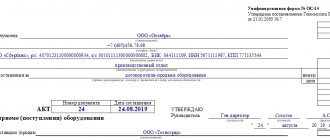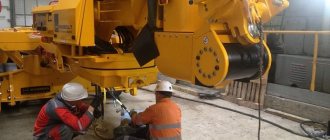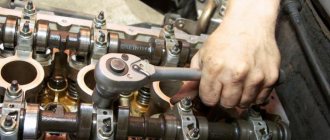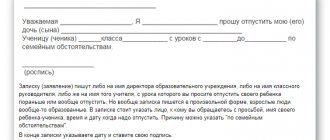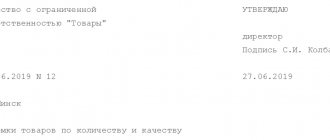A defect report is a table or list of defects that can be identified by a special commission after inspecting a construction site. If there are any, an appropriate conclusion is made, which indicates the state of the object at the moment.
When carrying out repair work at the site and recording all defects, this report is also drawn up. To draw up an act, it is necessary to create an on-site commission that will check the condition of the object, the level of its wear, the presence of certain malfunctions, and tell what kind of repairs need to be made (cosmetic or major).
A defect report (unified form OS-16) is issued if defects are identified in the equipment. A report can be drawn up in any form if other objects are being inspected.
You may also need the following documents:
- Premises inspection report
- Act of write-off of inventories
Application of OS-16
This document has a unified form. OS-16 was approved by Resolution of the State Statistics Committee of Russia dated January 21, 2003 No. 7. The form is not mandatory for use: an organization can independently develop a report form, for example, using this form as a sample, supplementing it with the necessary ones or vice versa, removing unnecessary details. The organization may also decide to use the approved Form OS-16. We will provide a unified form of the form and a sample of how to fill it out at the end of the article.
Depending on which forms the organization decides to use, you can either determine your own procedure for filling them out, or follow the instructions that apply to the unified forms. If you decide to use the established forms of unified primary documents, you should apply a filling procedure that meets the requirements of the instructions for them: some information on filling out the OS-16 form can be found in the instructions approved by Resolution of the State Statistics Committee of Russia dated January 21, 2003 No. 7.
When is this act completed?
This act is generated when, during the acquisition, installation, configuration or testing of newly acquired special equipment, defects and malfunctions were discovered in it that affect the fact that it is recognized as suitable for use as an operating system.
When special equipment arrives at the warehouse, an acceptance certificate is generated in form OS-14. If defects were detected upon receipt, a report on the presence of defects is generated already at this stage.
If no defects were found at the acceptance stage, the object is transferred for installation, and a report is generated in the OS-15 form. If defects and malfunctions are identified at this stage, an OS-16 act is also generated.
If no defects were identified at any stage, the special equipment is put into use. This is done on the basis of the transfer and acceptance certificate in form OS-1. Then an inventory accounting card is generated for it in the OS-6 form.
Depending on who is to blame for the defect, representatives of all companies that took part in the transportation process and production of special equipment may be involved in drawing up the act. At the same time, the form of the act may be slightly adjusted.
The number of copies of the generated document from the number of persons who signed it.
The OS-16 form report consists of two sheets. Its form is given below.
Filling out OS-16 (report of identified equipment defects)
In the header of the document, general data is filled in: name of the customer organization, structural unit, form code according to OKUD, OKPO. Next, fill in the document number and the date of its preparation.
In the main part of the document, first fill in general information about the accepted equipment:
- Number and date of the act according to which the equipment was accepted for installation;
- Place where the equipment is located (exact information: address, building, workshop number);
- Name of the manufacturer, OKPO code;
- Name of the supplier organization, OKPO code;
- Shipper's name, OKPO code;
- Name of the carrier company, OKPO code;
- Name of the installation company, OKPO code.
The following is a list of defects that were found in the equipment. Information about equipment that has been found to have deficiencies is presented in detail in a table of seven columns containing the following information:
- Equipment identification;
- Passport number or equipment marking;
- Brand of equipment;
- Project organization;
- Date when the equipment was manufactured;
- Date the equipment arrived;
- Defects that were found in the equipment.
Information for each piece of equipment is recorded separately in the table. Under the tabular part, the work that needs to be done to eliminate the identified defects, the performing companies that will carry out the necessary work, and the deadlines are indicated in detail.
The act is filled out by a representative of the organization installing the equipment. The document must be completed on the day the defects were discovered.
Act OS-16 is signed by a representative of the customer organization and a representative of the installation organization, indicating the position and a transcript of the signature. Further space is provided for printing and indicating the date. Further, a place is provided to indicate the signature of a representative of the manufacturer, indicating the position, transcript of the signature, and date of signature.
Each representative of the organizations that signed the document receives a copy of the act. One copy must be handed over to the installation organization, the second copy is intended for the customer, and the third for the equipment manufacturer. If necessary, additional copies can be compiled.
Form OS-16 (filling sample)
Methods
There are several common ways to determine defects in equipment operation:
| Carrying out an external inspection | Provides the ability to identify most defects, including dents, holes, obvious cracks, significant twists and bends, chips, broken solder, welded or adhesive joints, as well as many other possible faults. |
| Tactile check | Allows you to understand how worn and crumpled the threads on the equipment are, and the ease of turning various elements. |
| Tapping | Individual parts can be tapped using a soft hammer or handle to detect cracks by a rattling sound. |
| Kerosene test | It is carried out in order to detect the crack and its ends. The part is immersed in kerosene for up to 20 minutes, or the place where the defect is recorded is lubricated with kerosene, after which it is thoroughly wiped and completely covered with chalk. The kerosene that will protrude from the crack will moisten the chalk and make it possible to clearly understand where exactly the crack appeared. |
| Measurement | Using special measuring equipment, the amount of wear and play in various mating parts is determined, as well as the presence and extent of any deviations from the established size. |
| Hardness test | In accordance with the results of measuring the surface hardness of the part, the presence of any changes that occurred during operation is established. |
| Hardness test | Based on the results of measuring the surface hardness of various equipment elements, changes that have occurred in the material of the part during its operation are established. |
| Hydraulic test | Allows you to detect all kinds of cracks or cavities in body parts. To do this, any holes in the housing are carefully plugged, except for one, through which liquid begins to be pumped under the required pressure. If the walls fog up or a clear leak is noticeable, this will allow you to immediately determine the presence of a crack. |
| Magnetic check | A magnetic flux is used, which must pass through the part along with defects. Any changes are fixed by applying a special ferromagnetic powder in kerosene to the part, after which the powder should settle along the edges of the crack. |
| Ultrasonic inspection | It is based on the use of ultrasonic waves, which must be reflected from the boundary of two media. The reflected pulse must be registered on the installation screen with the specific location of the defect and its dimensions determined. |
| Luminescent test | It is based on the fact that some substances differ in that they glow in ultraviolet rays. |
Sample filling
Filling out the first sheet of the OS-16 act:
Customer: name of the organization that purchased the equipment.
Structural unit: the name of the unit where the equipment was received.
Act on transfer for installation: number and date of act OS-15.
Location: the address where the object in which the defects were identified is located.
Manufacturer: name and OKPO of the manufacturer.
Supplier: similar details of the organization that supplied the equipment to the customer.
Shipper: details of the person who sent the goods.
Carrier: similar details of the person who carried out the delivery.
Installation organization: details of the organization carrying out assembly and installation of equipment.
Clause 1 indicates at what stage the defects were identified - acceptance, installation, adjustment, testing.
The table contains data on identified equipment defects:
1-4 - information about the equipment in which defects were identified;
5, 6 — dates of production and receipt at the customer’s warehouse.
7 - describes the identified defects.
Filling out the reverse side of the OS-16 form:
On the reverse side of the form for a report on identified defects, the actions that need to be taken to eliminate problems and malfunctions are written. All measures to eliminate defects are described in detail.
The completed OS-16 forms are signed by representatives of the customer, the installation organization, and the customer.
and sample
act on identified equipment defects form OS-16 - link.
Form of report on equipment defects form OS-16 - download in word format.
If, during the process of acceptance, installation, adjustment or testing of purchased equipment, damage or malfunctions are identified, they can be documented in a report on identified equipment defects (form OS-16). Defects that were discovered during acceptance can be reflected in the equipment receipt certificate (OS-14). Typically, this document records deficiencies that can be detected during an external examination. If at this stage no faults or damage are detected, the equipment is transferred for installation. At the stage of installation and assembly of equipment, defects that impede operation may be identified that are not noticeable during external inspection; they must be documented in a report.
Conditions for application of the act
Form OS-15 is an act of acceptance and transfer of OS for installation work.
Situations when it is necessary to draw up an act of this form mainly arise in the construction industry, when the customer transfers special equipment to the contractor for installation.
This act is drawn up in two copies. One remains with the accounting employee, who is responsible for accounting for fixed assets, and the second is transferred to the contracting company along with special equipment.
If installation work is carried out under contract and the commission includes an authorized representative of the installation company, there is no need to draw up a separate copy of the document. When receiving objects for safekeeping, a representative of the installation company signs the document and receives a copy of the document.
The form of the act is given below.
We hand over the equipment for installation and prepare documents
Active account 08 “Investments in non-current assets” is intended for accounting of equipment installation. It is here that not only the cost of the installed equipment itself is taken into account, but also the costs associated with installation are collected. This means that when the equipment itself is transferred for installation, the accounting entry will be as follows (Order of the Ministry of Finance dated October 31, 2000 No. 94n):
Debit account 08 - Credit account 07
And when reflecting wiring installation work, the following may be:
Debit of account 08 – Credit of accounts 10 “Materials”, 60 “Settlements with suppliers and contractors”, 70 “Settlements with personnel for wages”, 69 “Settlements for social insurance and security”, 71 “Settlements with accountable persons”, etc.
To formalize the transfer of equipment for installation, Resolution of the State Statistics Committee dated January 21, 2003 No. 7 approved the form of the Certificate of Acceptance and Transfer of Equipment for Installation (form No. OS-15). This form, however, like the Act on Form No. OS-14, is not mandatory for use (Information of the Ministry of Finance No. PZ-10/2012). The organization itself decides whether to use these forms for these purposes or develop independent forms. It is only important that the primary source used is approved in the organization’s Accounting Policy for accounting purposes.
If an organization decides to use form No. OS-15, some features of its completion can be found in the Instructions approved in Resolution of the State Statistics Committee of January 21, 2003 No. 7. Thus, the act in form No. OS-15 is drawn up in at least 2 copies. At the same time, when installing using a self-employed method, i.e. using one’s own resources, an act is drawn up at the time of the actual transfer of the equipment for installation.
How to fill out the tabular part of a document
The columns of the tabular part of the act are filled in as follows:
- 1 – name of special equipment;
- 2 – serial number of the object;
- 3 – equipment passport number;
- 4 – equipment position number according to the technological diagram;
- 5 – type and brand of object;
- 6-7 – date and number of the act on the basis of which the equipment was received at the warehouse;
- 8 – number of objects in pieces;
- 9 – price of one object;
- 10 – total cost of all equipment;
- 11 – column for notes.
Work agreement

